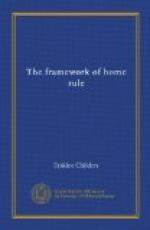Proposed, nevertheless, by a group of representative Irishmen, the scheme for a democratically constituted Department of Agriculture passed smoothly into law as soon as the machinery for ascertaining public opinion on the matters at issue had been brought into existence. Mr. Gerald Balfour, the Chief Secretary, was engaged at the time upon his measure for the extension of Local Government to Ireland. This measure became law in 1898, and the Department Act in 1899. Under that Act, the duty was laid upon each of the new County Councils of electing two members to serve upon a Consultative Council of Agriculture, to which a minority of nominated members was added, and this Council in its turn elects two-thirds of the members of an Agricultural Board, and supplies four representatives to a Board of Technical Instruction, which, like the Council and the Agricultural Board, has a predominantly popular character.[50]
At the summit stands the Minister, or Vice-President, as he is called (for in accordance with ancient custom, the Chief Secretary is nominally in supreme control of this as of all other Irish Departments), and a large and efficient staff of permanent officials. He and his staff have a large centralized authority, but this authority is subject to a constitutional check in the shape of a veto wielded by the Boards over the expenditure of the Endowment Fund. What is more important, policy tends to be shaped in accordance with popular views by the existence of the Council and the Boards.
Here, then, is the germ of responsible government. At first sight a critic might exclaim: “Why, here is democracy pushed to a point unknown even in Great Britain, where Government Departments are wholly independent of Local Councils.” That is in a limited sense true, and it is quite arguable that British Departments would be the better for an infusion of local control. But we must not be misled by a false analogy. Great Britain reaches the Irish ideal by other means. Her departmental Ministers are directly responsible to a predominantly British House of Commons where a hostile vote can at any moment eject them from office.[51] There is no Irish Parliament, nor any kind of predominantly Irish body which is vested with the same power. The Vice-President of the Irish Department of Agriculture, an institution concerned exclusively with Irish affairs, whether he sits in the House of Commons or not (and for two years Mr. T.W. Russell had not a seat at Westminster), could not be ejected from office even by a unanimous vote of Irish Members of the House, with the moral backing of a unanimous Irish people.[52] That is one of the anomalous results of the Union, and it was a recognition, though rather a confused one, of this anomaly, that inspired the ingenious compromise invented by the Recess Committee for introducing an element of popular control. But what a light the compromise throws on the anomaly which evoked it! Is it common sense to make these elaborate




